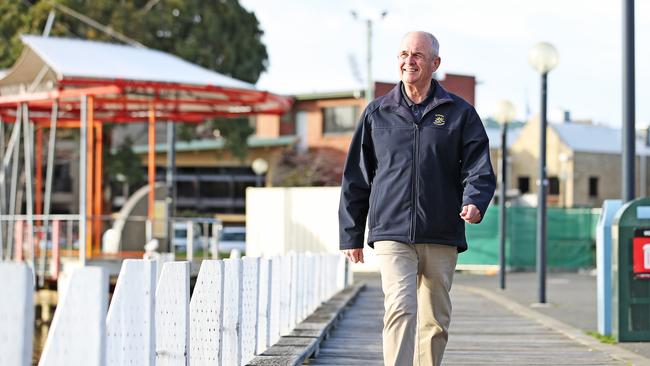Historic Richmond Bridge bears strain of Sorell’s traffic bottleneck woes, to undergo vibration test
A sandstone bridge built by convicts to carry horses and carts is now bearing the weight of traffic congestion woes and could be put under even more strain as a massive roadworks project looms.
Tasmania
Don't miss out on the headlines from Tasmania. Followed categories will be added to My News.
STRESS tests are being carried out on the historic sandstone bridge at Richmond as more traffic goes through the convict settlement to escape the Sorell bottleneck.
Resident Michael Wadsley said the almost-200-year-old bridge could become a victim of the Federal Budget and it was time to build a second link in the town to save its most prominent feature.
While commuters will ultimately reap big benefits from the $187m Sorell dual causeway project funded in this week’s budget, the Richmond Bridge will see even heavier traffic as commuters escape not only congestion but also roadworks.
“How much will the bridge’s life be reduced by the increasing load?,” Mr Wadsley asked.
“It was built to bear horses and carts. Will the bridge survive to enjoy it’s bicentenary?”
A Tasmanian Government spokesman said a vibration monitoring system on the bridge had not provided any evidence that the bridge was not coping with the current traffic.
“The load limit prevents vehicles exceeding 25 tonne from using it. There are no plans to strengthen the structure; however the monitoring system will be upgraded this financial year,” the spokesman said.

The bridge was built in 1823 to give road access from Hobart’s eastern shore to Tasmania’s east and south east including Sorell and Port Arthur.
Later causeways were built across two shallow bays giving more direct access to Sorell.
“Sorell is now one of Tasmania’s most rapidly growing municipalities and the causeways leading to Hobart have become traffic bottlenecks,” Mr Wadsley said.
“Drivers have rediscovered the road through Richmond as the most time-effective
route from Tasmania’s south east to Hobart’s northern suburbs. Day and night there is a continuous stream of vehicles past Richmond’s historic buildings and across the Richmond Bridge.

“There has been a plan in place for around 50 years to build a second river crossing at Richmond in order to assist preserving the historic bridge. The land reservations for this bypass are still in place.”
Clarence Mayor Doug Chipman said the council was also concerned about motorists detouring through Richmond to escape roadworks and was lobbying for the Richmond bypass completed.
“That bypass would stop motorists wanting to go west and east of the town having to travel through it and would involve another bridge over the Coal River,” Mayor Chipman said.
“It is listed as a road priority and we are talking to the State Government about it.”
It is also hoped express bus services will also help with traffic congestion issues during the upcoming Sorell causeway project.


